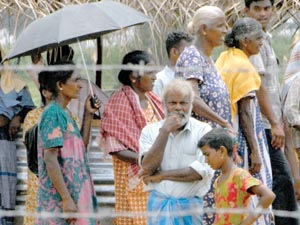By Dr. Muttukrishna Sarvananthan
 On July 13, the Central Bank of Sri Lanka (CBSL), on behalf of the government, announced the launch of “The Awakening North — A Special Loan Scheme for Resumption of Economic Activities in the Northern Province.”
On July 13, the Central Bank of Sri Lanka (CBSL), on behalf of the government, announced the launch of “The Awakening North — A Special Loan Scheme for Resumption of Economic Activities in the Northern Province.”
In order to revive livelihood activities in the north, an initial sum of LKR 3,000 million (circa 26 million dollars) is earmarked for lending to micro, small, and medium enterprises in the north at a concessionary interest rate of 12% per annum repayable up to a period of five years coupled with up to six months grace period.
The maximum amount per borrower is limited to LKR 200,000 (circa 1,739 dollars). Targeted sectors of the loan scheme are agriculture, livestock, fisheries, trade and self-employment ventures. Subsequently, on July 14, the CBSL made an announcement soliciting “Donations for the relief and resettlement operations for IDPs” from the general public, particularly from the diaspora.
These two consecutive public announcements through press releases of the Central Bank reveal the duplicity of the government as regards “The Awakening North.” Although the pretension appears to be revival of the economy of the north, these two public pronouncements together reveal the bankruptcy of the government and political motivation behind the subsidised loan scheme keeping in view the upcoming municipal council elections due to take place in Jaffna and Vavuniya in early August.
No money
Firstly, the solicitation of donations for IDPs’ welfare reveals that the government does not really have the money to fund the proposed loan scheme for micro, small, and medium enterprises in the north. If that is the case, why make this announcement?
My hunch is that, it is intended to woo marginal farmers, fisherpersons and petty traders into voting for the ruling party alliance at the upcoming local government elections in the north. Besides, the maximum amount borrowable under the loan scheme is grossly inadequate for effective upliftment of livelihoods of the people in the north.
Past experience shows that the majority of this type of state-sponsored and subsidised loans are appropriated by cronies of politicians — both the ruling and the opposition — and only a small proportion goes to really needy and entrepreneurial people. A similar concessionary credit scheme was implemented for enterprises affected by the tsunami throughout the country by the Central Bank during 2005.
The people have the right to know the full details about the disbursement of loans under that scheme by name, amount, district/province, etc. Will the Central Bank disclose this information?
The Central Bank and the government are hiding the dire straits of the economy from the people. For instance, the government had requested the International Monetary Fund (IMF) not to make the latest Article IV consultation report undertaken during the third quarter of last year (2008) public. Although it is the usual practice of the IMF to make this document public, it is the prerogative of any sovereign government to decide whether or not to make it public. Why is the government hiding the economic reality from the people even after the end of the civil war?
Disputed figure
Further, while it is claimed that the point-to-point rate of inflation has dropped dramatically to 0.9% in June 2009, anecdotal evidence from the markets and consumers dispute this telltale. Is the government fudging the numbers? Why does not the Central Bank disclose the overall balance-of-payments in its external sector performance data dissemination, which has been continuously and hugely negative since the last quarter of 2008?
Why has the Central Bank stopped the daily dissemination of exchange rates of foreign currencies, international oil prices, etc, since the second week of July 2009? Why has it stopped dissemination of weekly economic indicators? Central Bank has become economical with data dissemination.
There is a much simpler and less costly way of reviving the northern economy, which is to set the IDPs free immediately after completion of security screening. The President has told Time magazine that resettlement could begin after de-mining is complete in the Wanni.
As a matter of fact, a significant number of IDPs in the Wanni is originally from the Jaffna peninsula who were forcibly taken by the LTTE in late 1995 and early 1996 when the security forces took control of Jaffna. Therefore, they have their kith and kin, land, and perhaps dwellings as well in the peninsula and/or elsewhere.
There is no necessity for many IDPs to return to the former LTTE-controlled areas in the Wanni. Under such circumstances, why is the government still holding these IDPs? Setting the IDPs free would also save considerable money for the government.
Then, why is the government reluctant to release these IDPs? Is it to mobilise humanitarian aid from donors and donations from the diaspora and thereby bolster the foreign currency reserves of the government? Are the IDPs a pretext to solicit foreign donor funding for populist public spending in the run up to the upcoming parliamentary and/or presidential election/s (later this year or early next year)? Is the IDPs hostage to the economic imperatives of the government?
(For updates you can share with your friends, follow TNN on Facebook and Twitter )
